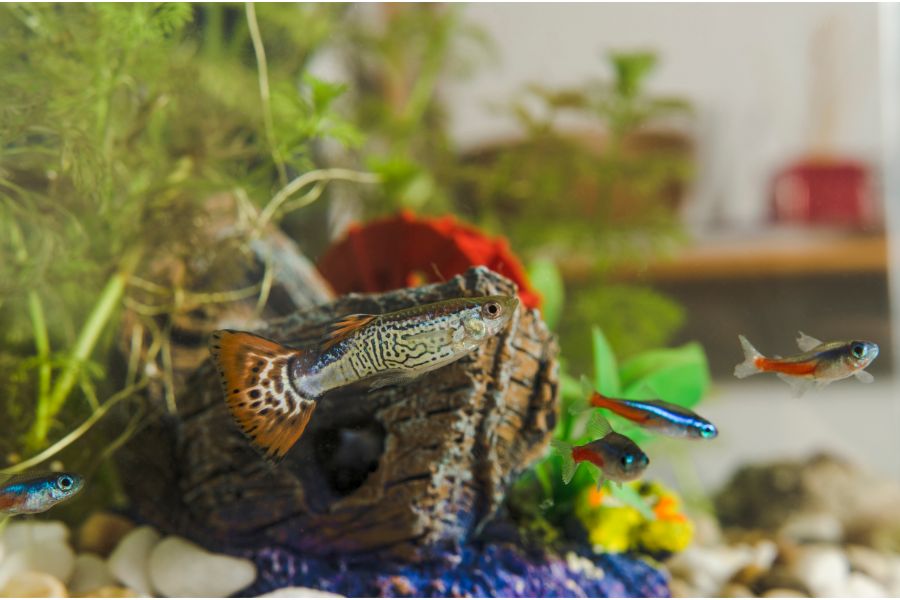Guppies and tetras are the first species that people go for their home tank. Guppies are well-known for their vibrant colors and resilience, whereas tetras are great tank species for their reasonable size and calm temperament.
Many aquatic enthusiasts are curious as to whether these two creatures can live in the same tank.
It is crucial to remember that despite the fact that guppies and tetras are both incredibly small, resilient, and usually simple to maintain, there are a few differences between them in terms of their water parameters, food preferences, and temperament.
Guppies are livebearers, which mean they produce offspring, whereas tetras lay eggs. Unlike guppies, tetras need significantly colder water conditions.
Therefore, it is important to learn these differences in order to develop a habitat that would allow both species to flourish.
The height of the aquarium, the population ratio, and other elements should also be taken into consideration, as they may influence the compatibility of certain fish.
We will continue to discuss the similarities, differences, tank setup requirements, water conditions, common diseases, and things to look after when housing tetras and guppies in the same tank.
Compatibility of Guppies and Tetras
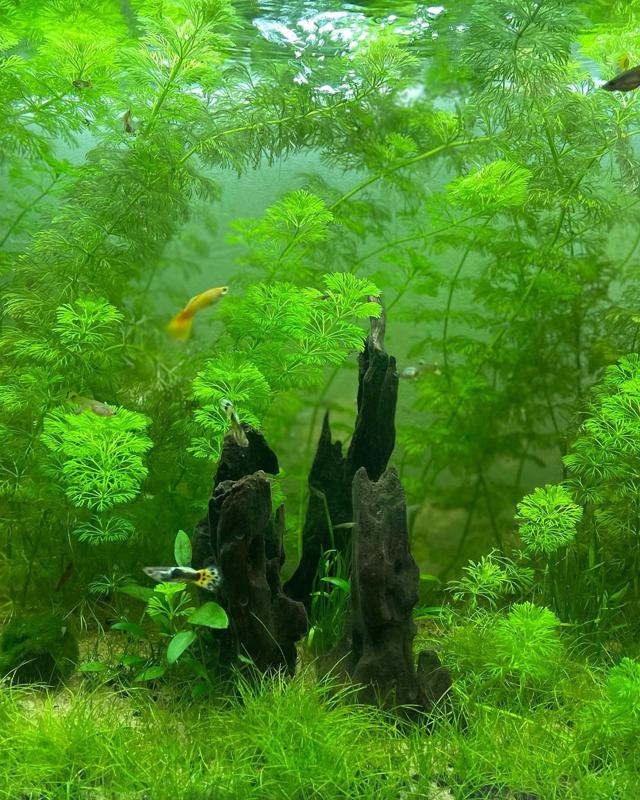
| Characteristics | Guppies | Tetras |
| Scientific name | Poecilia reticulata | Paracheirodon Axelrodi |
| Size | 1-2 inches | 1.5-2 inches |
| Lifespan | 2-3 years | 2-3 years |
| Water Temperature | 72-82°F | 72-80°F |
| pH Level | 7.0-8.0 | 6.0-8.0 |
| Hardness | Medium | Soft to Medium |
| Diet | Omnivorous | Omnivorous |
| Temperament | Peaceful | Peaceful |
| Social behavior | Schooling fish | Schooling fish |
Similarities and Differences Between the Two Species
Guppies and tetras are indeed tiny, lively species that are common in fishkeeping. In terms of beauty, guppies are famous for their bold and beautiful color schemes, whereas tetras exhibit more diversified colors.
Guppies are available in many different colors, including red, orange, yellow, blue, green, and purple. However, tetras come in a number of shades, like red, yellow, pearl, neon, and black.
Guppies and tetras are really small species, with guppies achieving a maximum length of 2 inches and tetras normally measuring roughly 1.5 inches. But, many tetra varieties may evolve to be 2 inches long.
Guppies have a unique and distinctive appearance as they have a triangular-shaped end and their lateral fins start right below their head to their end.
Male guppies typically possess long, streaming fins, especially on the lateral and posterior fins. Interestingly, female guppies feature relatively short fins with a more contoured physique. Males show a far better color vibrancy in guppies.
Tetras, in contrast, have a longer, more extended appearance, and their lateral fin is situated at the end of their bodies. Additionally, their wings are comparatively bigger, and their bodies are quite sleek.
It is especially the case with fish like neon and Cardinal tetras. The males exhibit extended and more angular wings, whereas the female features small and rounded fins.
Guppies are well-known for having a diverse variety of color varieties and markings. They are available in a variety of styles, including solid, patterned, and more.
Although tetras can be found in a few colors, they lack the intensity and color schemes that guppies feature.
Water Requirements for Guppies and Tetras
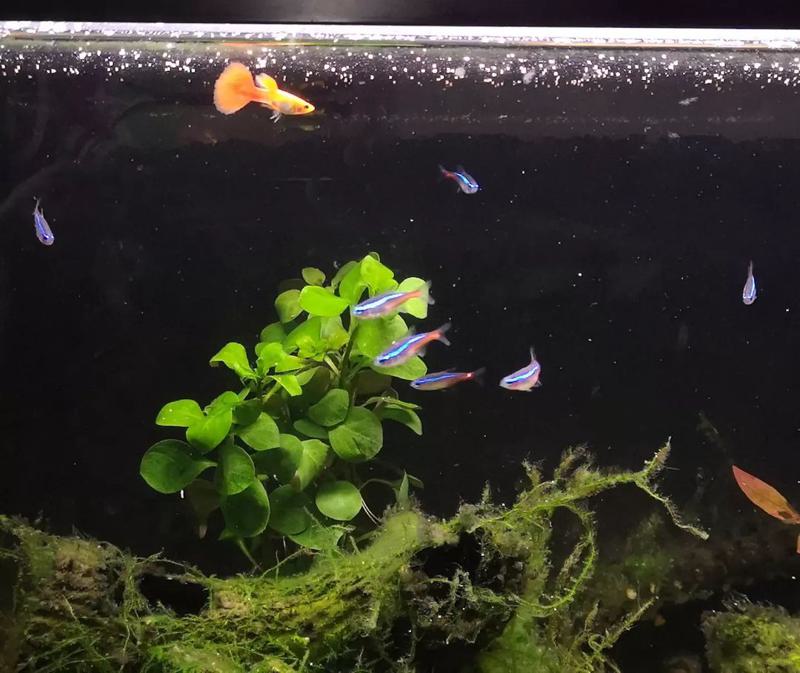
When housing guppies and tetras inside a shared aquarium, it is important to understand their unique water needs.
Guppies enjoy a pH range of 7.0-8.0 as well as a water hardness range of 5-15 dGH. They have a considerable amount of water tolerance and could adjust to a variety of pH and acidity conditions.
Guppies enjoy water temperatures ranging from 78 to 82 degrees Fahrenheit and will withstand severe and cold temperatures.
Whereas, tetras require water temperature that ranges from 72 to 80 degrees Fahrenheit and has a pH of 6.0 to 8.0. Additionally, they enjoy the water with a hardness level ranging from 2 to 10 dGH.
They can tolerate a certain amount of nitrite and ammonium as well, but it is your duty that their environment remains steady and these concentrations stay within acceptable ranges.
These freshwater species require a higher level of dissolved oxygen in their home tank. So to achieve this, you need to install an air bubbler to provide them with sufficient water current.
It is advised to routinely test the water for pH, hardness, chlorine, ammonia, nitrate, and nitrite levels and make modifications as necessary to maintain stable water conditions for both guppies and tetras.
Researchers conducted a study where they explained how tetras and guppies live in extremely acidic situations. Cardinal, neon, and emperor tetras are small South American characin fish that can tolerate low pH levels; they can survive in water with a pH of 3.5 and even lower.
Guppies, on the other hand, cannot survive in acidic water and die after 11 days in the water with a pH of 4.75. Both guppies and tetras lose large amounts of body sodium when exposed to acidic water.
In order to eliminate any accumulated waste and debris, uneaten food, clean the filter and the decorations, and wash down the tank glass to replace necessary minerals and trace elements, it’s also needed to do regular water changes of roughly 25–30% of the water in the tank every week.
Additionally, it’s imperative to utilize a high-quality water conditioner to get rid of chlorinated water and liquid ammonia from groundwater because these could be dangerous for both creatures.
Additionally, it’s vital to maintain a constant aquarium temperature because abrupt fluctuations in temperature may upset fish and increase their susceptibility to illness. A high-quality tank heating element or compressor could assist in maintaining the tank’s temperature steady.
Feeding Habits and Dietary Needs
Both guppy and tetra species are omnivores, which implies they consume both leafy and meat products. Despite having similar feeding behaviors, their nutritional requirements could be a little different.
Guppies are famous for being messy eaters, meaning they would devour anything that is provided to them. They usually consume a lot of tiny freshwater creatures in their natural habitat, like shrimp, bugs, and larvae.
They may be given a diversity of items in tank life, including shavings, pellets, refrigerated items, and raw foods. They also enjoy vegetables like leafy greens or boiled lettuce. You should only feed them 2-3 times a day.
Fish owners should also understand that certain tetra types could demand more specific dietary needs. For instance, many tetra genera might enjoy a high intake of plant products, whereas others might like a diet packed with animal protein.
They can also devour tiny species, parasites, larvae, insects, and a lot more in their natural environment. Fish keepers have also witnessed that these species like to munch on floating vegetation, small plants that have soft leaves, and pollen that settles onto the tank substrate.
Whereas in the tank environment, they enjoy high-quality pellets, flakes, shavings, frozen foods like brine shrimp, daphnia, bloodworms, and leafy vegetables like lettuce and spinach.
Tetras are shoaling fish, which means they frequently eat in schools. It is advised to give them little amounts of food 2-3 times every day. Tetras, like the majority of fish, should be given a variety of foods to make sure they get all the nutrients they need.
As a result, it’s usually advised to do some study on the particular species you intend to maintain in your tank in order to better understand their nutritional requirements.
It’s crucial to check that both types of fish are receiving adequate food and aren’t out-eating one another while keeping guppies and tetras together in the same tank.
Social and Territorial Behavior
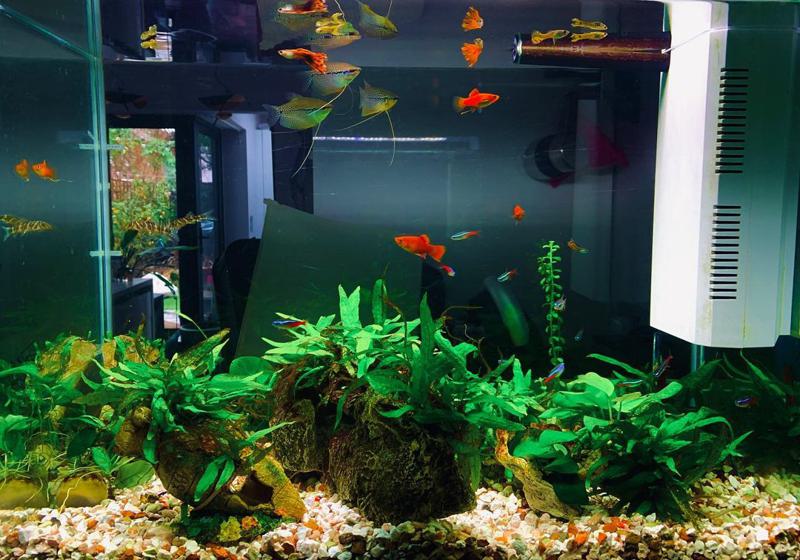
Since guppies like to live in groups, they are considered to be communal species. They get along nicely in shared aquariums with other friendly fish species since they are not territorial.
Guppies are known to be energetic swimmers and may be housed alongside other fish species with similar swimming patterns and water needs. Additionally, guppies have a record for being tough fish that adapt well to various tank settings.
Tetras are known worldwide for being highly social fish that love to dwell in communities. They tend not to be territorial, but if they see another fish species as a danger to their shoal, they could turn violent.
They thrive in communal aquariums with other calm fish species and are renowned for being powerful swimmers. Some tetra species may be calmer than others, and some may have particular tank requirements and tank mates.
It’s crucial to take social behavior and territoriality into account while housing guppies and tetras in the same aquarium. To minimize violence, it’s critical to provide them with enough space and keep them in groups of at least 6-8 species.
Related: Best Guppy Tank Mates
Potential Diseases
Like other fish, guppy and tetra species are prone to various illnesses. The following are some of the prevalent ailments that can affect guppies and tetras:
- Ich: Guppies and tetras are susceptible to the parasite illness ich. It is distinguished by little white markings on the body and fins of the fish. Several drugs, including malachite green, formalin, and copper sulfate, can be used to treat ich.
- Fin Rot: Fin rot is a bacterial illness that causes tearing and discoloration of the fins and tail. It may be treated with a range of medications, including erythromycin, tetracycline, and nitrofuran, and is frequently brought on by bad water quality.
- Dropsy: Dropsy is a disorder that causes the scales and belly of the fish to inflate. It is frequently brought on by bad water quality and is treatable with a number of drugs including kanamycin and neomycin.
- Swim bladder dysfunction: A fish with swim bladder dysfunction has trouble controlling its buoyancy. It may be cured by adjusting the fish’s diet and making sure the water is of the highest quality. It can be brought on by overfeeding and poor water quality.
- Columnaris: The bacterial illness Columnaris can cause ulcers on the fish’s body. Different antibiotics, including erythromycin and tetracycline, can be used to treat it.
- Neon Tetra Disease (NTD) – NTD is more prominent in Neon Tetras but affects many types of fish. It is a parasitic disease caused by Pleistophota hyphessobryconis Symptoms include white cysts/lumps, discoloration, swimming difficulties, and immobility. NTD is a fatal disease that usually leads to euthanasia and there is no known cure for it. However, it is rare and easily preventable once you apply the right preventative measures.
Additionally, it’s crucial to look for any illness-related symptoms, like fatigue, appetite loss, or unusual swimming habits. It’s necessary to act quickly to treat the problem if you see any of these symptoms.
It can entail changing the water regularly, modifying the water’s properties, or giving medicine as recommended by a veterinarian.
Setting up a Guppy and Tetra Tank
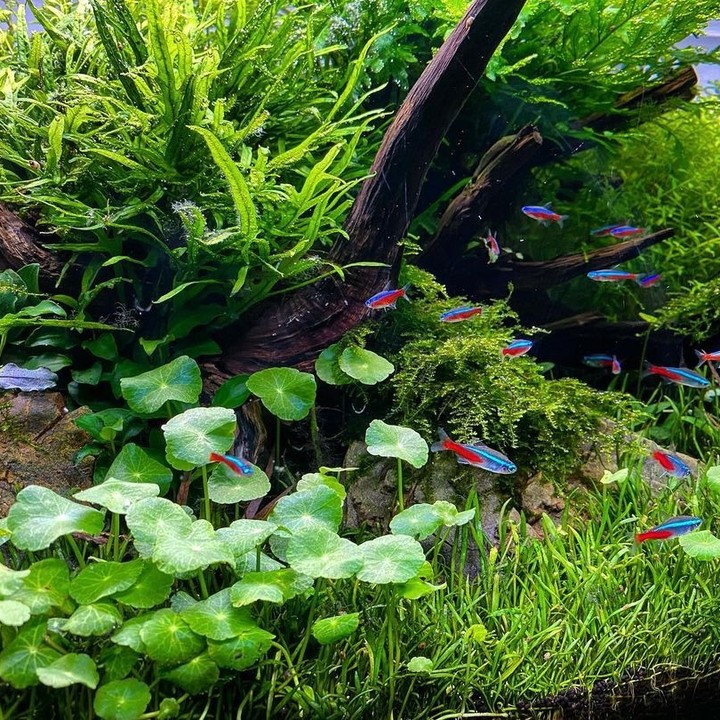
It’s crucial to think about the right tank size and supplies when keeping guppies and tetras together to guarantee the fish have adequate space and ideal living circumstances.
Tank size: Both guppies and tetras are energetic swimmers and need enough room to roam around. For a small group of 3-5 guppies and 6-8 tetras, a tank with a minimum capacity of 50 gallons is advised. However, a bigger tank is usually preferable to provide them with more space to swim.
Filtration: A good filtration system is vital for sustaining stable water conditions and excellent water quality.
Aeration: Tetras and guppy require a moderate to a high concentration of oxygen in their habitat. You may add more aeration by using an air pump or air stone.
Heating: Tetras and guppies prefer water that is between 78°F and 82°F (25.5°C and 28°C). It is critical to choose a high-quality heater capable of keeping the water temperature within this range.
Lighting: While guppies and tetras don’t need specific lighting, they do benefit from the natural daylight cycle. To provide the species with a sensation of day and night, a light that simulates the natural daylight cycle can be employed.
Decorations: Decorations such as caverns, boulders, and driftwood can serve as hiding spots, hatching grounds, and natural environments. However, it’s necessary to stay away from items that can hurt the fish or make it challenging for them to swim.
Live plants: Live plants may aid by removing toxins, supplying oxygen, and providing protection for guppies and tetras. They may also be a fantastic source of fish food. A few well-liked options for living plants are hornwort, anubias, and java moss.
Breeding Process of Guppies and Tetras
Mating: Guppies and tetras will mate in the presence of a proper habitat and a male-to-female ratio that is balanced. For guppies, the females will lay their eggs, and the males will fertilize them. For Tetras, the males fertilize the females’ eggs after they lay them on the tank’s plants or other surfaces.
Incubation: Guppies’ eggs are carried inside the female for around 4-6 weeks of gestation, after which the female gives birth to live fry (10 to 60). When it comes to tetras, the eggs hatch within 24 to 36 hours of being deposited safely (20 to 100).
Fry care: Guppies and tetras’ fry will be born fully grown and ready to swim and feed right away. They will need infusoria or other tiny food to live.
Separation: It is advised that the fry be placed in a separate tank or breeding net to avoid the adult fish from consuming them. It will increase the chances of the fry growing and developing without being consumed by adults.
Remember that guppies and tetras are susceptible to poor water quality, and that water temperature, pH level, and water hardness can have an impact on how well they reproduce.
In order to encourage reproduction, it is crucial to maintain steady water conditions and provide them with diversified healthy food.
Related:
- Can Guppies Live With Bettas?
- Can Goldfish Live with Guppies?
- Guppies and Mollies: Can Live Peacefully Together
- What is Neon Tetra Disease?
Guppies and Tetras: FAQs
Can Guppies and Tetras Breed in The Same Tank?
Yes, Guppies and tetras can breed in the same aquarium if it is set up with the necessary settings, including the right water parameters, enough room, and ideal living conditions.
But, the survival rate of the fry can be increased by isolating them from the adults.
Can Guppies and Tetras Live in A 10-Gallon Tank?
It is possible for a small number of guppies and tetras to live in a 10-gallon tank. But it’s important to ensure proper equipment, filtration system, and water parameters suitable for both species.
Overcrowding should be avoided, and research on specific fish is recommended for the best living conditions.
Do Guppies and Tetras Nip Each Other Fin?
Guppies and tetras are usually calm fish; therefore, they don’t nip at each other’s fins. Some variants of guppies and tetras are more aggressive or territorial than others, and their behavior may differ.
Conclusion
At last, having guppies and tetras in the same tank might be a fantastic choice for fish hobbyists. Both species can add beauty to any freshwater tank because of their vivid colors and lively personalities.
However, it’s crucial to remember that they have significant differences in terms of water conditions, nutrition, and mating process, which must be considered while setting up their tank.
Additionally, it’s essential to conduct your investigation on the particular guppies and tetra species you intend to maintain, as some may be more aggressive or territorial than others.
Your guppies and tetras can live harmoniously in a thriving and healthy environment if you give them the proper care and surroundings.
